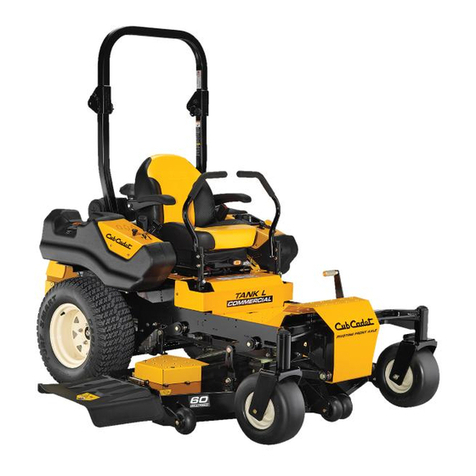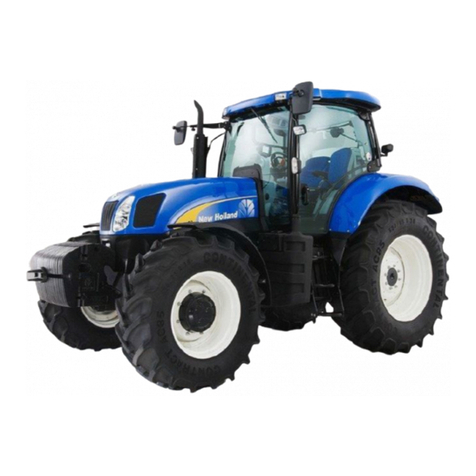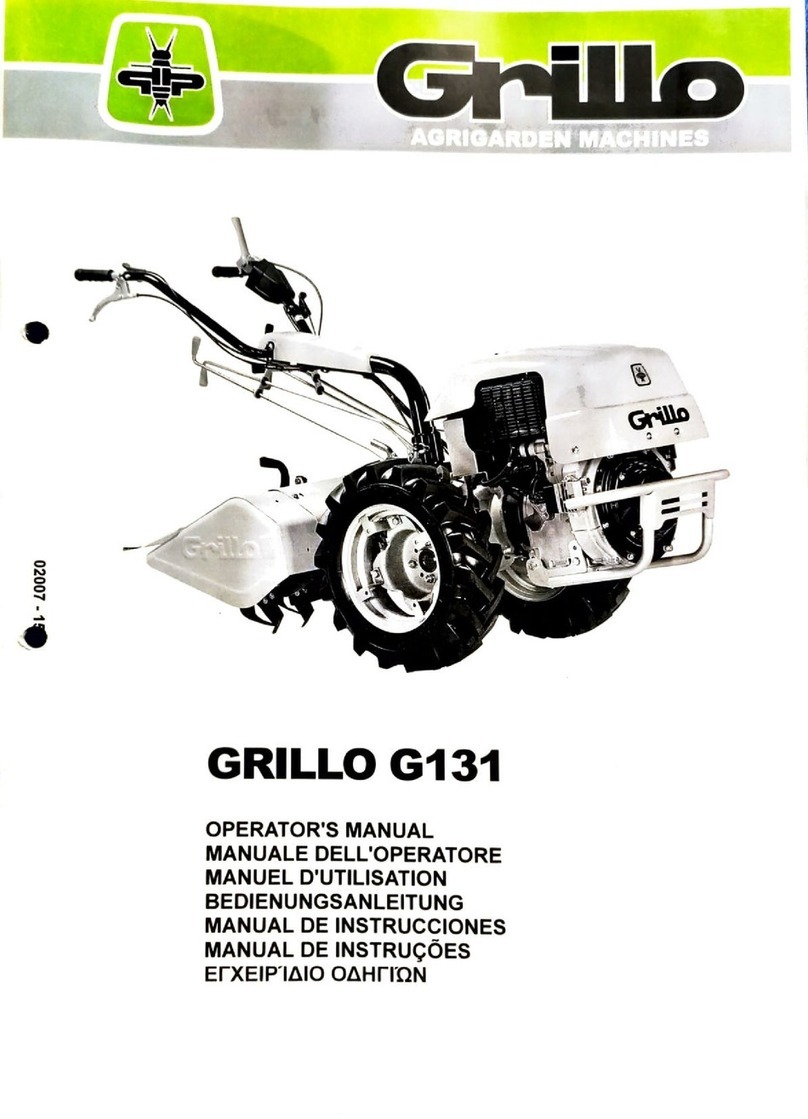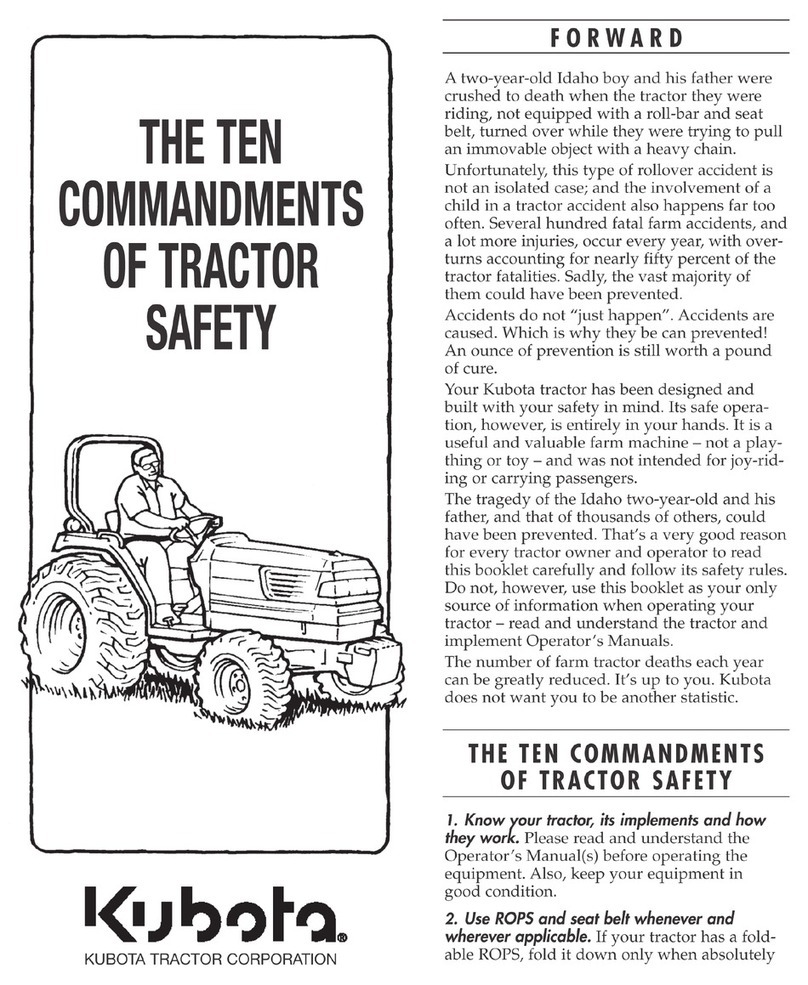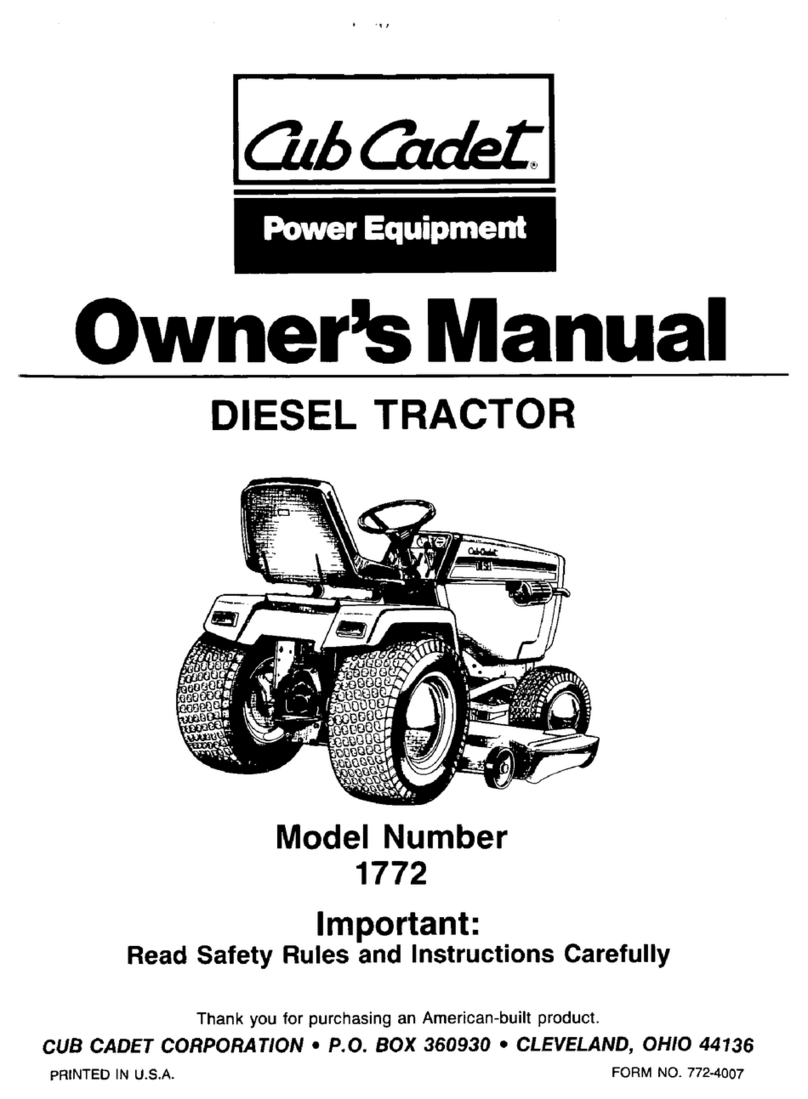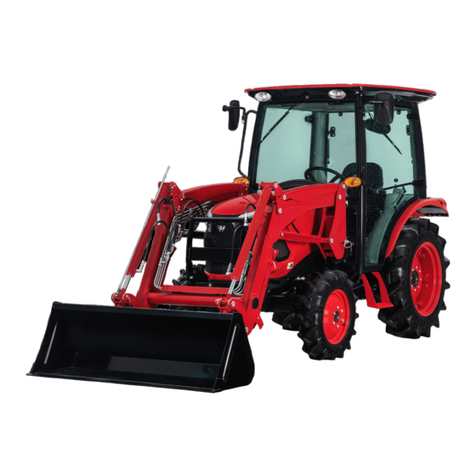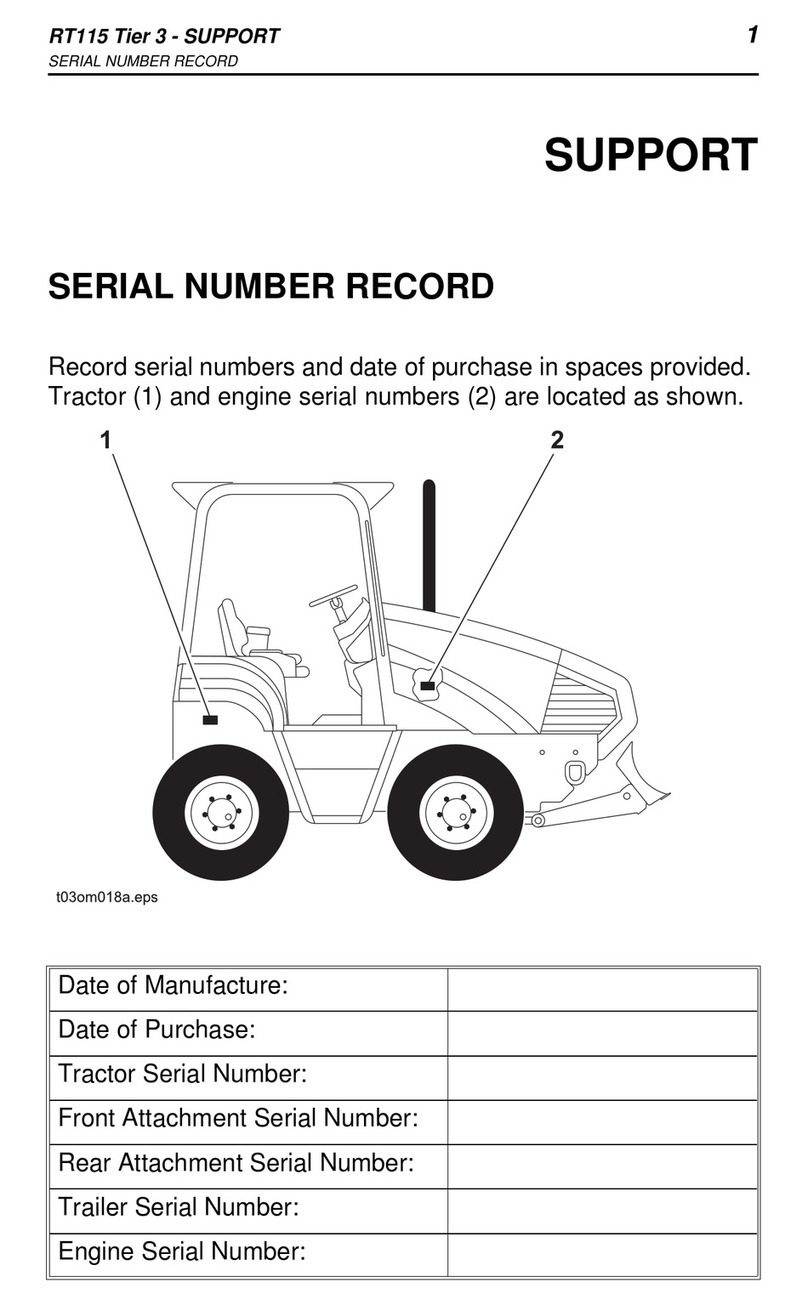DIGGERKING King 2.3 Digger User manual

King 2.3 Digger
Manual for Operation

2
Contents
Safety Warning Signs .................................................................................................................... 5
Signal Words................................................................................................................................. 6
Foreword...................................................................................................................................... 6
Serial number ............................................................................................................................... 7
Machine Description .................................................................................................................... 8
Designated Operations....................................................................................................................... 8
Product Features ................................................................................................................................ 8
Operate as per the following instructions: ....................................................................................... 8
Notes about Reading of This Manual ................................................................................................ 8
Safety ........................................................................................................................................... 9
General Precaution............................................................................................................................. 9
Abiding by All Safety Regulations ...................................................................................................... 9
Upon detection of machine abnormality.......................................................................................... 9
Operating Temperature Range.......................................................................................................... 9
Wearing Appropriate Clothing and Protective Appliances ............................................................ 10
Setup of Signaler and Flagman ........................................................................................................ 11
Precaution for Standing up from or Leaving Driver........................................................................ 11
Toxic Exhaust Gas from Engine........................................................................................................ 13
Guard against Crushing and Cuts..................................................................................................... 14
Precaution during Preparations....................................................................................................... 14
Understanding of working zone ...................................................................................................... 14
Daily Checking and Maintenance .................................................................................................... 15
Precaution within Cab (If installed) ................................................................................................. 15
Safety Measures at Start .................................................................................................................. 16
For Cold Weather ............................................................................................................................. 17
Operation Precaution....................................................................................................................... 17
Checking of Visibility before Operations of Machine ..................................................................... 17

3
Checking for Safe and Reliable Working Zone before Operations................................................. 18
Checking of Chassis (Tracks) before Traveling ................................................................................ 18
Precaution for Traveling on Slopes.................................................................................................. 19
Precaution for Parking...................................................................................................................... 25
Safe Lifting of Machine..................................................................................................................... 26
Safe Transport of Machine............................................................................................................... 27
Precaution for Maintenances .......................................................................................................... 27
No Disassembling of Track Tensioner.............................................................................................. 32
Disconnection of Battery Cables...................................................................................................... 32
Jumper Start with Battery Charging Cable ...................................................................................... 33
Asking Your Service Dealer for Welding Repair .............................................................................. 34
Vibration Applied on Operator ........................................................................................................ 34
Checking after Maintenance............................................................................................................ 34
Safety Signs (Markings) .................................................................................................................... 35
Safety Sign (Markings)...................................................................................................................... 36
Warning Signs ................................................................................................................................... 37
Controls...................................................................................................................................... 40
Maintenance .............................................................................................................................. 72
Maintenance List .............................................................................................................................. 83
Walk-Around Checking ........................................................................................................... 84
Daily routine checking (Every 10h)......................................................................................... 85
Every 50h................................................................................................................................. 91
Every 100h............................................................................................................................... 93
After first 250h (For new machine only)................................................................................ 94
Every 250-hour........................................................................................................................ 94
Every 500-hour........................................................................................................................ 97
Every 1000h............................................................................................................................. 97
Every 1500-hour...................................................................................................................... 99
Every 2000h............................................................................................................................. 99

4
Maintenances during Long-Time Parking ................................................................................. 106
Troubleshooting ....................................................................................................................... 108
Symptoms other than Malfunctions.............................................................................................. 108
Engine Overheating ........................................................................................................................ 108
No Battery Power ........................................................................................................................... 109
Burnout of Fuse .............................................................................................................................. 111
Restart after Refueling ................................................................................................................... 112
Flashing of Warning Lamps ............................................................................................................ 113
Other Symptoms............................................................................................................................. 114
Towing...................................................................................................................................... 116
Damage of Cab or Shelter......................................................................................................... 116
Support:.................................................................................................................................... 117

5
Safety Warning Signs
WARNING!
This sign denotes a safety warning.
Please read and understand this information to prevent personal injuries.
The machine owner or employer is responsible for instructing every operator to
operate all equipment correctly and safely. All personnel operating this machine shall
sufficiently understand the contents of this manual.
Before operating the machine, all operation personnel must receive the guidance on
related functions of excavator.
Before operating this machine in a working site, learn and practice how to use the
machine controls correctly in a safe place.
Improper methods of operation, checking, and maintenances of machine could result in
injuries or deaths. Before any operation, checking, or maintenance of machine, please
read and understand this manual.
Please always carry this manual with you. It’s preferable to preserve this manual on the
machine. If this manual is lost or damaged, please immediately order a new manual
from a dealer. At the transfer of this machine, please ensure to hand this manual over
to the new owner.
The machine supplied by us conforms to the local standards and specifications of
Australia. If your machine is purchased from other country or from an individual or
company of other country, this machine is probably not installed with the safety devices
or safety standards required for the operations of this machine in your country. If you
have any doubt on the compliance of your machine with the relevant standards and
regulations in your country, please contact your dealer.

6
Signal Words
The safety information in this manual and machine identifications is indicated by words “Danger”,
“Warning”, and “Notice”. The meanings of these signal words are as below:
Danger
“Danger” denotes high dangerous level, for which negligence will result in death or serious injury.
Warning
“Warning” denotes medium danger level, for which the negligence may result in death or serious
injury.
Notice
“Notice” denotes low danger level, for which the negligence will result in minor or medium
injuries.
Important: The word “Importance” is intended to alert the operation and maintenance personnel
of the possible damages of machine and its components.
T warnings in this manual or on this machine can’t cover all possible accidents. Therefore, during
the operation of the machine, ensure to take caution and abide by all conventional safety
measures to prevent harm to machine, operation personnel, or other personnel.
Foreword
This manual describes the operation, checking, and maintenances of this machine and the safety
descriptions to be observed during operations.

7
Should you have any doubt, please contact your dealer.
Please be noted that the information contained in this manual and the parameters of this
machine are subject to changes without further notice.
Serial number
Important: Do not disassemble the machine nameplate with serial number. Observe the serial
numbers of machine and engine and record them in the blank area below.
Machine No.:
Engine No.:

8
Machine Description
Front, Rear, Left, and Right
The front, rear, left, and right of the machine
indicated in this manual are based on the
status sitting in the driver seat, with the
bulldozing blade visible in the front.
Designated Operations
This machine is mainly applied for following
operations:
•Digging
•Ditching
•Side ditching
•Leveling
•Loading
Product Features
•“Flexible machine width structure”
track width
•Low engine noise and emission
•Run-in First 100h (Based on reading of hour meter) for new machine
Operate as per the following instructions:
Using a new machine without running-in will deteriorate acceleration performance and probably
shorten the life of machine.
Sufficiently warm up the engine and hydraulic oil.
Avoid heavy-load and rapid operations.
Maintain the load at approximately 80% of maximum load capacity during operations.
Do not start, accelerate, steer, or stop suddenly, unless it’s really necessary.
Notes about Reading of This Manual
Please be noted that the descriptions and graphics contained in this manual are general
representations for your guidance.
Left
Front

9
Safety
General Precaution
You are liable for abiding by the safety laws and regulations of relevant departments
and fulfilling the operations, checking, and maintenances of machine.
Please read and understand all safety information related to the prevention of accidents.
Please ensure to operate the machine only after you have understood how to operate, check,
and maintain the machine correctly.
Abiding by All Safety Regulations
The machine must be operated, checked, and maintained by trained and qualified personnel.
During the operations, checking, and maintenance of machine, ensure to understand and abide
by all rules, regulations, precaution, and safety measures.
Do not operate, check, or maintain the machine under the adverse influence of alcohol, drug,
medicine, or fatigue.
Upon detection of machine abnormality
During the operation, checking, or maintenances of the machine, if any abnormality is detected
(Such as noise, vibration, smell, abnormal instrument, smoking or oil leakage, error warning
indication, and abnormal display of electric control panel), immediately notify a sales or service
dealer and take appropriate measures.
Do not operate the machine before the abnormality is resolved.
Operating Temperature Range
To maintain performance and prevent the early wear of machine, please abide by the following
operating conditions.
Do not operate the machine when the outside temperature is more than+45℃or less than-15℃
The operations under +45℃outside temperature may result in engine overheating and
deteriorated engine performance. In addition, the hydraulic oil may become really hot which may
cause harm the hydraulic devices.
Operations under-15℃outside temperature may harden the rubber parts (Such as gaskets) and

10
cause earlier wear or damage of machine.
To operate the machine under conditions outside the above-mentioned temperature range,
please consult with your sales or service dealer.
Wearing Appropriate Clothing and Protective Appliances
Installation of Fire Extinguisher and
First-Aid Kit
Do not wear loose clothing or items that may
catch on any joystick or moving parts.
Do not wear oil or fuel contaminated clothing.
Wear safety shoes, safety helmet, safety
goggles, filtration mask, thick gloves, earflaps,
and other protective equipment. During the
use of grinding miller, breaking hammer, or
compressed air, please wear appropriate
protective appliances, such as safety goggles
and filtration mask, as the splashing of metal
chippings or other objects can cause serious
harm.
Please use the hearing protection devices
during the operations of machine. Exposure
to a high noise environment for a long time
will result in harm or even complete loss of
hearing.
Install the fire extinguisher and first-aid kit and learn how to use them. Please refer to the
instructions on the fire extinguisher and first aid kit.
Compile an emergency contact list and know who to contact in an emergency in your area.
In Australia dial 000 for emergencies.
No Disassembling of Safety Devices
Always keep all safety devices in good working order.

11
Setup of Signaler and Flagman
Learn how to use the gestures of specific
operation needs and designate the person
responsible for making gestures.
All personnel must completely understand all
gestures.
The operator must respond to the gestures of
the designated person only. However, the
operator must abide by the stop gesture
made by anyone in all cases.
The signaler must stand in a clearly visible place while making the gestures.
Precaution for Standing up from or
Leaving Driver
Before standing up from the driver seat to
open/close windows or disassemble/install
the lower window, lower the working device
onto the ground, lift up and lock the safety
lock handle and stop the engine. When the
safety lock handle is lowered down
(Unlocked), accidental movement of the joystick can result in sudden movement of machine and
may cause serious injuries or deaths.
Know how to use safety lock handle, seat belt, and other safety devices and understand the
correct operation methods.
Do not disassemble any safety device, unless for the purpose of checking and repair.
Please ensure that all guardrails, shelters, and doors are installed properly and securely. Before
operating the machine, please repair or replace damaged parts.

12
Please be noted that, even if the safety lock
handle is placed at locking position, the
bulldozing blade, boom, and auxiliary hydraulic
controls can’t be locked. Do not touch controls
accidentally.
While lifting up or lowering down the safety
lock handle, take caution not to touch any
joystick.
Before leaving the driver seat, lower the
working device onto the ground, lift up the safety lock handle to locking position, and stop the
engine. Meanwhile, ensure to withdraw the key, close the doors and hoods, and carry the key
with you and then preserve it in a designated place.
Guard against Fire and Explosion Dangers
Keep fuel, lubricating oil, grease, and
antifreeze away from flame. The fuel is
especially flammable and dangerous. Handle
these flammables away from ignited
cigarettes, matches, lighters, and other flame
or ignition source.
Do not smoke or use open fire while handling
fuel or performing the operations of the fuel
system.
Do not leave the operation site while filling
fuel or lubricating oil.
Do not disassemble the fuel tank cap or refuel while the engine is running or is not cooled down.
In addition, do not splash fuel to any machine hot surface or electronic system part. Immediately
clean the overflown fuel or lubricating oil thoroughly.
Check for leakage of fuel and lubricating oil. Please eliminate the leaks and clean the machine
before operation.
Please move the flammables to a safe place before polishing or welding operations. Do not cut or
weld any pipeline or pipe that may contain flammable liquid. Please clean thoroughly by non-
flammable solvent before cutting or welding.

13
Remove all wastes and impurities from the machine. Ensure that there is no oil contaminated
rags or other flammables on the machine.
Handle all solvents and dry chemicals (Foam fire extinguisher) as per the manufacturer’s
procedures indicated on the container. Operate in a well-ventilated place. Never use fuel for
cleaning purpose.
Always use non-flammable solvent. Please ensure thorough ventilation during the handling of
fuel and the cleaning of oil stain or paint. Preserve all flammable liquids and materials in a safe
and well-ventilated place.
The short-circuit of the electrical system may result in fire. Check the wire connections daily for
looseness and damage. Re-tighten loose connectors and cable clamps. Repair or replace
damaged wires.
Fire accident caused by pipelines: Ensure that the clamps, protection devices, and cushion pads
of hoses and pipes are securely fixed. If loose, the hoses and pipes will be damaged due to
vibration or contact with other parts during operations. This may result in spraying of high-
pressure oil to cause fire accident or harm.
Toxic Exhaust Gas from Engine
Do not operate the engine in an enclosed place with poor ventilation. If natural ventilation is not
possible, install ventilation fan, fan, extended
exhaust pipe, or other ventilation device.
Handling of Asbestos Powders
The inhalation of asbestos powders may
cause lung cancer. While handling materials
that may contain asbestos, take the following
safety measures:
Do not sweep with compressed air.
Avoid polishing or grinding asbestos-
contained parts.
During cleaning, use a vacuum device installed with high-efficiency particulate air filter (HEPA).
If there is no other method for control of powders, please wear the specified respirator. During
indoor operations, please install a ventilation system with polymer filter.

14
Guard against Crushing and Cuts
During operations, non-authorized personnel
are prohibited to access the working zone.
Please strictly abide by the rules and
environmental standards applicable for this
working zone.
Never place your hand, foot, or other body
parts between the superstructure and chassis
or tracks, between machine body and working
device, or between cylinder and motion parts. During movement of machine, these clearances
will change and may cause serious injuries or deaths.
Precaution during Preparations
Understanding of working zone
Before starting operations, understand the
situation of working zone to ensure safety.
Check the terrain and ground situation of working
zone. For indoor operations, check the building
structure and when necessary, take safety
measures.
Ensure to keep away from dangers and obstacles
such as water ditch, underground pipelines, trees,
cliffs, overhead cables, and roads with falling stone
or landslide danger.
Check the positions of underground gas pipelines, water
pipelines, and electric cables together with administrator. If
necessary, discuss with administrator to determine the detailed
safety measures to be taken to ensure safety.
During operations on road, ensure to take the safety of
pedestrians and vehicles into consideration. Use a signaler
and/or signals. Isolate the working zone against access to non-
authorized personnel.

15
Before operations in water or driving through shallow rivers, check the water depth, ground
firmness, and flow rate in advance. Understand more operation description information with
reference to the “Precaution during Operations” Checking of Bridge Strength
Please check the permissible load before driving on bridges or structures. If the strength is
insufficient, reinforce the bridges or structures.
Always Keeping Clean Machine
Wipe away lubricating oil, grease, mud, snow, and ice,
in order to prevent accident due to slip. Eliminate all
loose objects and unnecessary devices in the machine.
Remove dusts, lubricating oil, and grease from engine
portion to prevent fire accident.
Clean the area around operator's seat and remove all
unnecessary objects from the machine.
Daily Checking and Maintenance
Before operations, fulfill the designated checking
and when necessary, repair immediately. In event of
operation failure due to
malfunction or engine malfunction, immediately
stop the engine as per stop procedure and park the
machine securely, till the malfunction is repaired.
Precaution within Cab (If installed)
Before entering the cab, remove mud and oil/grease from your shoes. Operating the machine
pedals with soiled shoe bottoms may result in accidents due to slips.
Do not place any part or tool around the driver seat.
Do not place any plastic bottles in the cab or install any suckers on window glasses. The plastic
bottle or suckers can play a lens role and increase the chance of fires.
Do not use a mobile phone during traveling or operations.
Do not bring any inflammable or explosive into cab.
Do not leave a lighter in the cab. The lighter may explode due to the rise of room temperature.

16
Safety Measures at Start
Support your body weight by three-point safety posture while
getting on/off the machine.
Do not jump on or off the machine. Do not attempt to get on or off
a moving machine.
Before getting on or off the cab, firstly open the door completely to locking position and check
and ensure that the door can’t move further (For machine with cab).
Face towards the machine, get on/off the footplates, and grab the handrail to support your
weight by three-point safety posture (Hands and feet). Do not use safety lock handle or any
joystick as handrail.
Start the engine only after the safe start is confirmed by checking the following items.
Adjust the seat till it’s securely locked.
Fasten the seat belt.
Check whether the parking device is actuated and all joysticks and pedals are
in neutral.
Check whether the safety lock handle is at locking position.
Ensure there is no person near the machine.
Start and operate the machine only in driver seat.
Do not attempt to start the engine by short circuiting the terminals
Before starting machine, keep all non-authorized personnel away from this zone
Walk around the machine and alert the repair personnel and the personnel walking around the
machine. Start the engine only after it’s confirmed that there is no person around the machine
Check for warning sign “No Operation” or similar sign affixed on cab door, control, or starter
switch. If present, do not start engine or touch any joystick.
After the start of engine, fulfill following operations and checking in a place without personnel or
obstacle. Upon detection of any malfunction, stop the engine as per the procedure and report
malfunction.
Sound the horn to alert the personnel around machine.
Sit in the driver seat and start the engine.
Warm up the engine and hydraulic oil.
Check all instruments and warning devices for normal functioning.
Check for presence of noise.
Test the engine speed control.
Operate all control devices to ensure normal functioning.

17
Start by Jumper Cable
Start by jumper cable only as per the recommended method.
The improper use of jumper cable may result in battery
explosion or unexpected machine motions.
Please refer to “In event of no battery power” to understand
more operation description information.
For Cold Weather
Take caution that the frozen ground, footplates, and handrails are
slippery. In cold weather, do not touch any metal part of machine by
bare hands. Your skin may be frozen on metal parts which may cause
serious injuries.
Do not use diethyl ether or starting fluid on the engine. The starting
fluid can cause explosion and serious injuries or deaths.
Warm up the engine and hydraulic oil. Operating joysticks without warm-up will result in slow or
inappropriate reaction or movement of machine which could lead to accidents.
Operation Precaution
Operating Machine with Maximum Track Width
Always operate the machine with extended
track width of 1,240mm, in order to improve
the machine stability to the maximum extent.
Operating the machine with narrow track
width (990mm) may result in rollover of
machine due to poor stability.
If it’s necessary to operate the machine with
narrow track width (990mm), retract the
bucket working device and lower the boom to
reduce the gravity center and face the machine towards front before traveling.
Checking of Visibility before Operations of Machine
During operations in a dark place, turn on the working lamp and headlamp of machine and when

18
necessary, install additional lighting devices. In event of poor visibility due to severe weather
(Such as fog, snow, rain, and haze), stop the operations of machine till the visibility turns good.
Clean the windows, mirrors, lamps, and camera to keep good visibility. Adjust the mirrors and
camera to optimal positions to ensure that the driver sitting in the driver seat can see the rear
view (Blind spot).
The non-authorized modification or the installation of non-approved attachments may impair the
visibility of the operator.
No Riding on Machine
All personnel are prohibited to sit on any part of machine at any
time during traveling or operations of machine.
Checking for Safe and Reliable Working Zone before
Operations
Verify the performance limits of machine.
Set up a signaler at the road shoulders, narrow places, or vision-
obstructed places.
Do not allow any person to access the turning radius or path of
machine.
Sound the horn to indicate your movement intention.
There are blind zones behind the machine. Before driving
backward, check the safety in the area behind machine and ensure there is no person behind the
machine.
Checking of Chassis (Tracks) before Traveling
Bulldozing blade
Before operating the traveling joystick/pedal, ensure that
the bulldozing blade is in front of the driver seat. Please
bear in mind that the operation direction of the traveling
joystick/pedal with bulldozing blade behind the driver
seat is reverse to that with bulldozing blade in front of
driver seat.

19
Safe Traveling
The bulldozing blade shall be lifted during traveling. Retract the
bucket working device as shown in above diagram and lift the bucket
by 30~40cm off the ground.
Do not slew during the traveling. If it’s necessary to operate the
bucket working device during traveling, operate at sufficiently low
speed to ensure complete control at all times.
When the machine is traveling in 2nd gear (High speed) and a load
higher than set value is applied, the machine will automatically slow down to 1st gear (Low
speed). If the load is reduced, the machine will accelerate and return to 2nd \ gear (High speed).
Please be noted that the traveling speed varies depending on the load condition (For machine
with automatic traveling gearshift reducer system).
Do not drive the machine on a slope steep enough to cause instability of machine. Please be
noted that, in the actual applications, the performances of machine on a slope will be
deteriorated due to severe working conditions.
Downhill
Avoid driving over obstacles whenever possible. If it’s necessary to
drive over obstacles, keep the bucket operating device near the
ground and travel at low speed. Do not drive over any obstacle that
will incline the machine by 10° or larger.
On rugged roads, drive the machine at low speed and avoid the
sudden startup, stop, and direction change. Otherwise, the working
device may come into contact with the ground to cause unbalance and damage of machine or
destruct the structure in surrounding area.
Precaution for Traveling on Slopes
While traveling on slopes, take caution to prevent the rollover and
gliding of machine. Keep the driver seat facing towards the upslope
direction while climbing up a slope. Keep the driver seat facing towards
the downslope direction during downslope traveling. In both cases, pay
special attention to the ground ahead of the machine during traveling.
While traveling on a slope, lower the bucket to 20~30cm off the ground.
While climbing up a steep slope, extend the bucket working device to
the front position. In event of an emergency, lower the bucket onto the
ground and stop the engine of machine.
While traveling on a slope, drive slowly in 1st gear (Low speed). Reduce the engine speed during
downslope traveling. Do not reverse the machine down a slope.

20
Special Caution for Operations of Machine on Ice/Snow
While traveling on snowy or icy roads, drive at low
speed and avoid the sudden startup, stop, and
direction change.
In snowy regions, the road curbs and the roadside
objects are buried in the snow to become invisible. In
addition, there is a danger of machine rollover or
collision with covered objects. Therefore, always
operate with caution.
There is a danger of rollover or snow entrapment
while driving the machine into thick snow. Drive with
caution and do not drive over road curbs or entrap in
the snow. For frozen soil surface, the ground
becomes soft when the temperature rises, which
may result in rollover of machine and entrapment of
operator in the machine.
While parking the machine on an unstable ground,
lower the bulldozing blade.
Special Caution for Operations of Machine on Ice/Snow
While traveling on snowy or icy roads, drive at low speed and avoid the sudden startup, stop, and
direction change.
In snowy regions, the road curbs and the roadside objects are buried in the snow to become
invisible. In addition, there is a danger of machine rollover or collision with covered objects.
Therefore, always operate with caution.
There is a danger of rollover or snow entrapment while driving the machine into thick snow. Drive
with caution and do not drive over road curbs or entrap in the snow. For frozen soil surface, the
ground becomes soft when the temperature rises, which may result in rollover of machine and
entrapment of operator in the machine.
While parking the machine on an unstable ground, lower the bulldozing blade.
Table of contents
Popular Tractor manuals by other brands
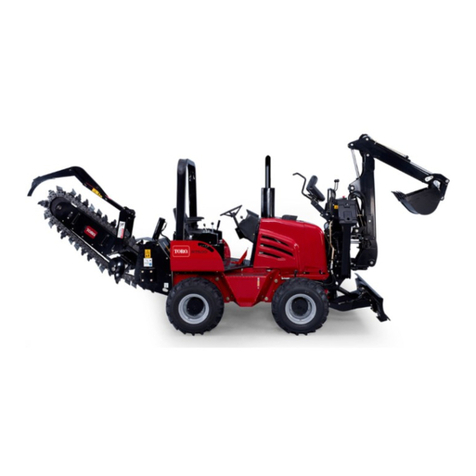
Toro
Toro 25430 Operator's manual
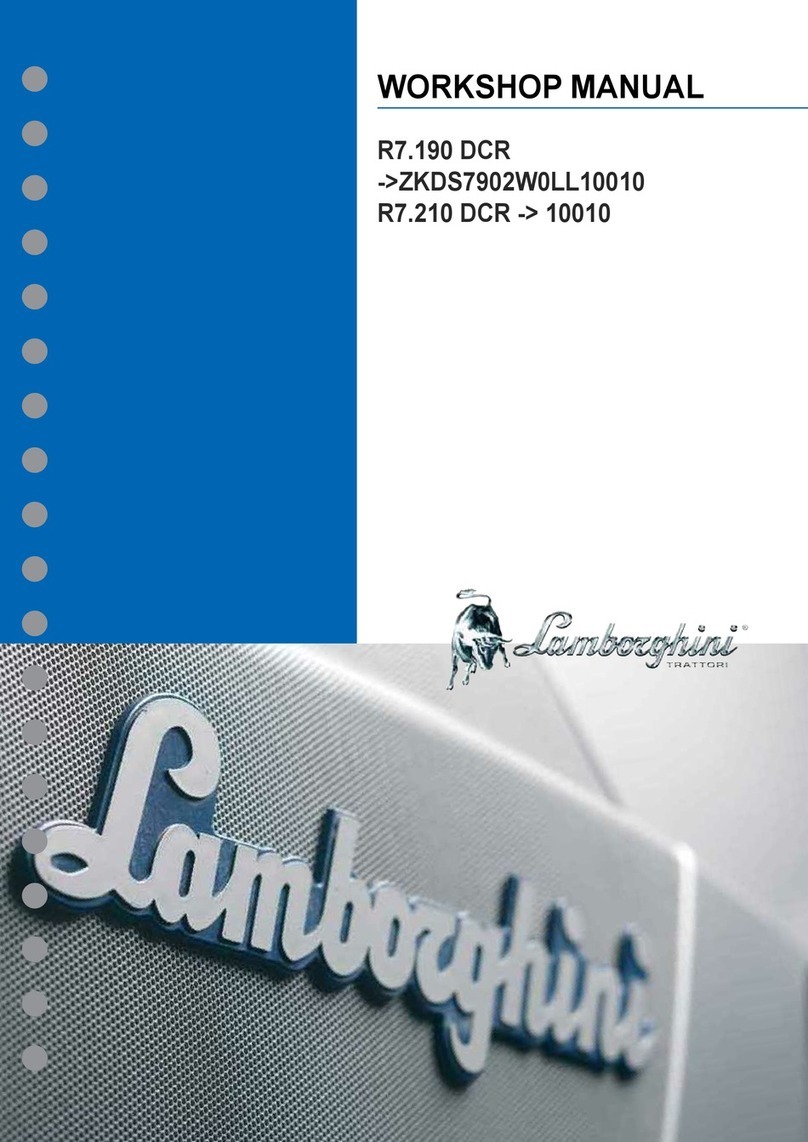
LAMBORGHINI
LAMBORGHINI R7.190 DCR Workshop manual
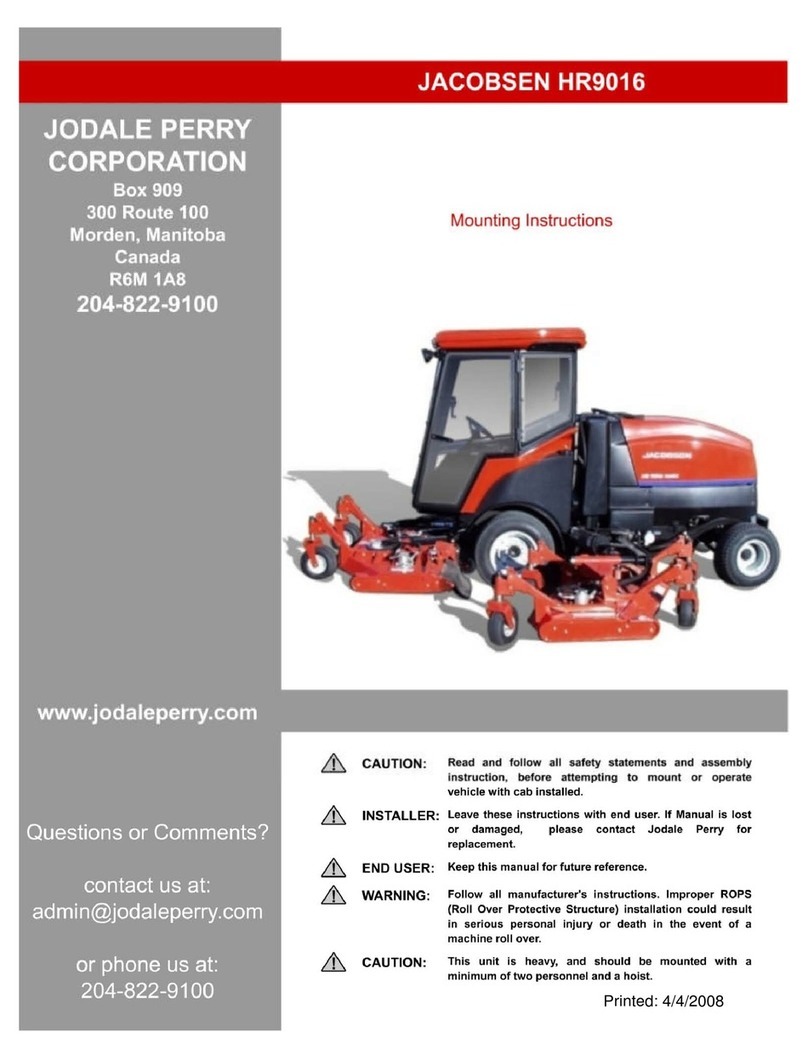
Jodale Perry Corporation
Jodale Perry Corporation Jacobsen HR9016 Mounting instructions

Mitsubishi Heavy Industries
Mitsubishi Heavy Industries BD2G manual
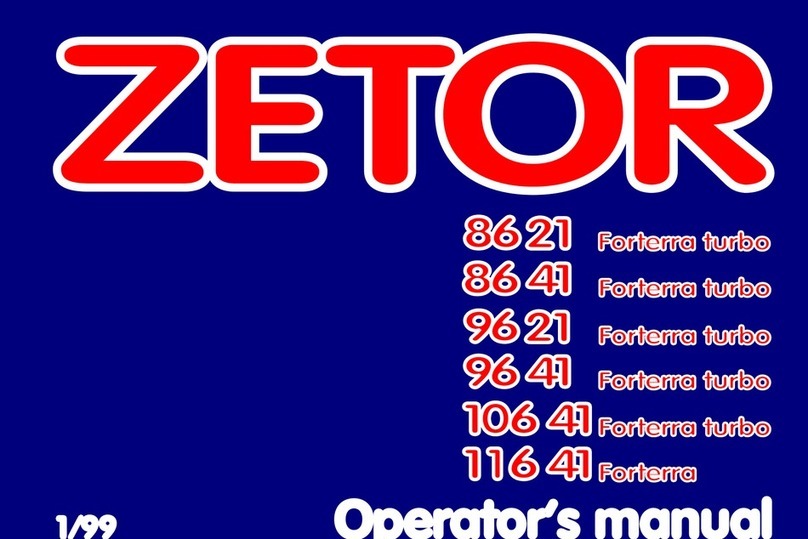
Zetor
Zetor 8621 Forterra turbo Operator's manual
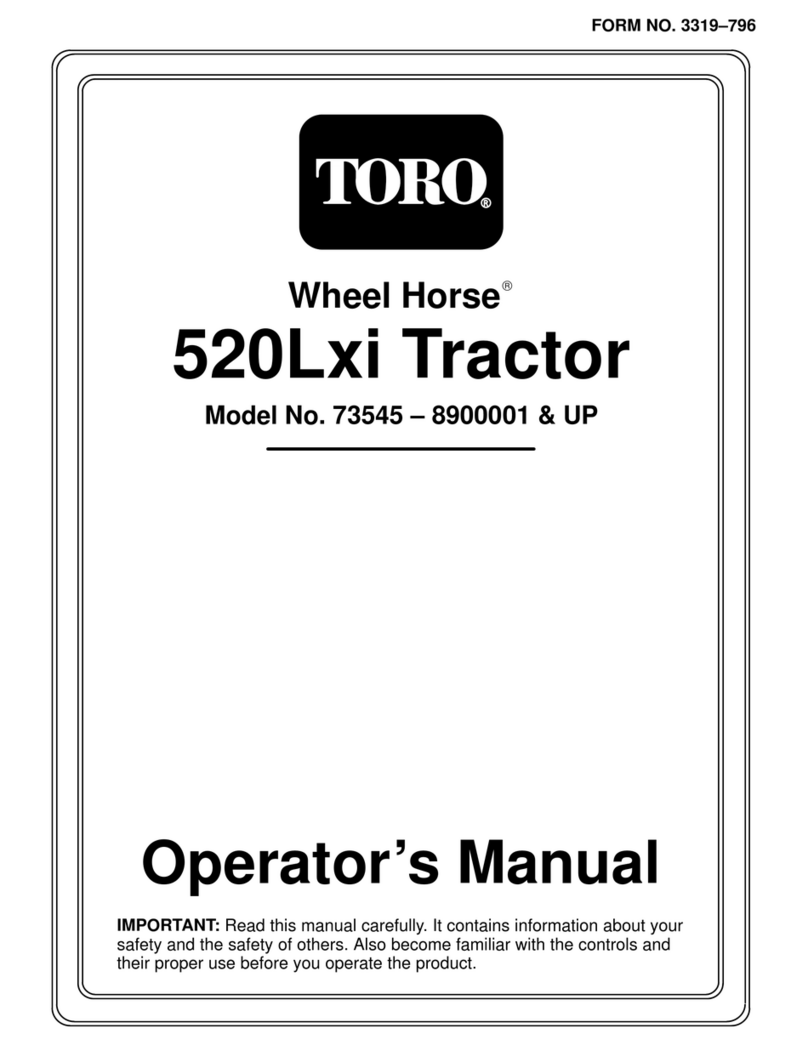
Toro
Toro 73545 Operator's manual

